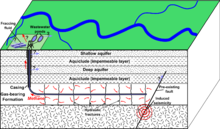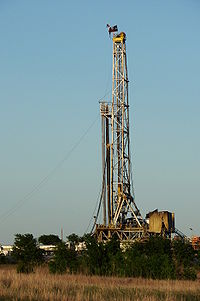
| Fracking |
|---|
 |
| By country |
| Environmental impact |
| Regulation |
| Technology |
| Politics |
Environmental impact of fracking in the United States has been an issue of public concern, and includes the contamination of ground and surface water, methane emissions,[1] air pollution, migration of gases and fracking chemicals and radionuclides to the surface, the potential mishandling of solid waste, drill cuttings, increased seismicity and associated effects on human and ecosystem health.[2][3] Research has determined that human health is affected.[4][5] A number of instances with groundwater contamination have been documented due to well casing failures and illegal disposal practices,[6] including confirmation of chemical, physical, and psychosocial hazards such as pregnancy and birth outcomes, migraine headaches, chronic rhinosinusitis, severe fatigue, asthma exacerbations, and psychological stress.[7] While opponents of water safety regulation claim fracking has never caused any drinking water contamination,[8] adherence to regulation and safety procedures is required to avoid further negative impacts.[9]
As early as 1987, researchers at the United States Environmental Protection Agency (EPA) expressed concern that fracking might contaminate groundwater.[10] With the growth of fracking in the United States in the following years, concern grew. "Public exposure to the many chemicals involved in energy development is expected to increase over the next few years, with uncertain consequences" wrote science writer Valerie Brown in 2007.[3] It wasn't until 2010 that Congress asked the EPA to conduct a full study of the environmental impact of fracking.[11] The study is ongoing, but the EPA released a progress report in December 2012 and released a final draft assessment report for peer review and comment in June 2015.[12]
- ^ "Methane Leaks Wipe Out Any Climate Benefit of Fracking, Satellite Observations Confirm". ThinkProgress.
- ^ Cite error: The named reference
house1was invoked but never defined (see the help page). - ^ a b Cite error: The named reference
HeatOnGaswas invoked but never defined (see the help page). - ^ Bamber, AM; Hasanali, SH; Nair, AS; Watkins, SM; Vigil, DI; Van Dyke, M; McMullin, TS; Richardson, K (15 June 2019). "A Systematic Review of the Epidemiologic Literature Assessing Health Outcomes in Populations Living near Oil and Natural Gas Operations: Study Quality and Future Recommendations". International Journal of Environmental Research and Public Health. 16 (12): 2123. doi:10.3390/ijerph16122123. PMC 6616936. PMID 31208070.
- ^ Wright, R; Muma, RD (May 2018). "High-Volume Hydraulic Fracturing and Human Health Outcomes: A Scoping Review". Journal of Occupational and Environmental Medicine. 60 (5): 424–429. doi:10.1097/JOM.0000000000001278. PMID 29370009. S2CID 13653132.
- ^ Fischetti, Mark (August 20, 2013). "Groundwater Contamination May End the Gas-Fracking Boom". Scientific American. Vol. 309, no. 3.
- ^ Gorski, Irena; Schwartz, Brian S. (25 February 2019). "Environmental Health Concerns From Unconventional Natural Gas Development". Oxford Research Encyclopedia of Global Public Health. doi:10.1093/acrefore/9780190632366.013.44. ISBN 9780190632366. Retrieved 20 February 2020.
- ^ Cite error: The named reference
AutoZV-21was invoked but never defined (see the help page). - ^ Costa, D; Jesus, J; Branco, D; Danko, A; Fiúza, A (June 2017). "Extensive review of shale gas environmental impacts from scientific literature (2010-2015)". Environmental Science and Pollution Research International. 24 (17): 14579–14594. Bibcode:2017ESPR...2414579C. doi:10.1007/s11356-017-8970-0. PMID 28452035. S2CID 36554832.
- ^ Cite error: The named reference
Urbina 03Aug2011was invoked but never defined (see the help page). - ^ "The Debate Over the Hydrofracking Study's Scope - Document - NYTimes.com". archive.nytimes.com. Retrieved Apr 14, 2020.
- ^ "Unconventional Oil and Natural Gas Development". 2013-01-15.